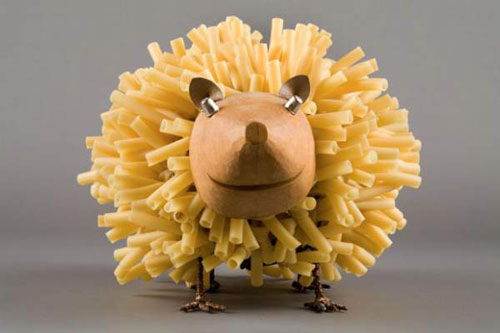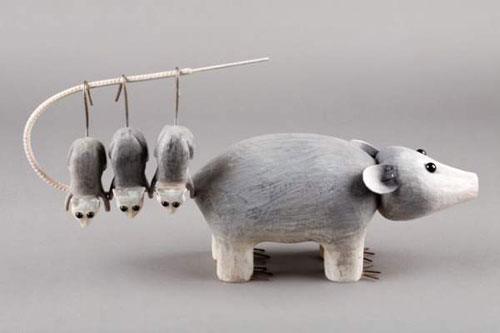The ArchRecord Interview: Alan Maskin

Sheep
Photo: © Grant Mudford.

Hedgehog
Photo: © Grant Mudford.

Opossums
Photo: © Grant Mudford.

Owl
Photo: © Grant Mudford.

Penguins
Photo: © Grant Mudford.

Crane
Photo: © Grant Mudford.

Tigers
Photo: © Grant Mudford.

Warthog
Photo: © Grant Mudford.








JM: Tell me about the ark design.
AM: We felt Jim Olson, who has 30 years experience designing residences with our firm, would be the perfect person to work on the residence for Noah and his animals. It’s designed in an abstraction sort of way: it’s pulled away from the walls, ceilings, and Jim and the team used different devices to make it feel like the ark is much larger. There’s different ways, with mirrors, that effects are created. It actually fools people: people walk in and they want to know how they can get to the galleries beyond.
AM: The idea is to create a sense that this boat is much, much larger than it actually is, than the 8,000 square foot we could fit it in. But something very interesting happened when we were researching the project early on. We had an architectural intern in our office sit down and take the Old Testament. There’s a portion where God supposedly tells Noah the exact dimensions of the ark and gives it to him in cubits. A cubit is the distance on a man’s arm between his elbow and the top of his fingers: it’s about 16 to 18 inches. So we had an intern make a computer model based on the cubits that are described in the Old Testament. About a day later, he called me over and said: I need you to look at the computer model, because I think we’ve made a terrible mistake. It was 450 feet long, that’s a football field and a half. It was 75 feet wide. It was 45 feet tall. That’s very long.
Simultaneous to this we had interns researching the ways the ark had been represented in western art and culture—actually, not just western art, all sorts of cultures—and it’s been in stories, paintings, and art, and we had hundreds and hundreds of images. But in no images we found was the ark actually represented to its true scale and proportion. So we’re very intrigued with this. We couldn’t fit an actual ark the true size we were given except in one dimension: the ark width, from the entry to the exit, is in fact 75 feet wide, so it gives you some sense of at least the reference from the Old Testament.
JM: How is the ark laid out in the exhibit?
AM: As you enter there’s a wall where the ark is under construction on one side—and you can actually help to build the ark—when you walk in the beginning it’s Noah’s first day on the ark. But as you move to the end of the project, you’ve been on the ark for a while and the material is darker. It’s been 40 days and 40 nights, presumably, and it’s worn out and it’s actually finished. So by the time you get off on this side, it’s actually 75 feet wide. So in that dimension, you get the sense of its scale. The long dimension is where we actually used the device of mirrors and devices like that to make it feel like it’s much, much larger.
JM: What other inspirations did you have for the design?
AM: One of the things that was interesting about this project was that at the beginning, five and a half years ago, the exhibit developer, Marni Gittleman, took the design team out to meet with children they were hoping would come to it. We met with a group of kindergarteners in a portion of L.A. that is a Spanish-speaking. We wanted to get a sense from them what it is that they would be interested in—and did they even know about the Noah’s ark story? We wanted them not just to tell us what they wanted to do, but we wanted them to show us. So we gave them paper, and it was broken up into boxes like a cartoon so the kids could draw in sequence.
We had different people going to different classes and I bet we had about 60 drawings on the table and we studied them. One of the things we started to notice was every single kid, almost to a letter, had included a ramp with animals boarding onto the ark. It occurred to us that that was an incredibly important aspect: no one was saying it, but they showed it to us every single time.
The exhibit is an exact outgrowth of what the kids taught us. There’s a hay-bailer-type deal with animals that have been made and painted by kids in the Los Angeles school community and kids can march all the animals up and load them: a direct relation to meeting with the museum visitor and having them tell you basically, through drawings, what they wanted to see.
JM: What was it about the ramp and the idea of getting things onto the ark that was so necessary to the kids?
AM: When we were looking at the representations of art and children’s stories through time, the actual boarding of animals coming from the jungle onto the ark has been represented over and over again. There is something about that aspect all of these animals leaving their lives, moving onto this boat, and embarking on a voyage—it’s a sort of immigration story on some levels. They’re heading off for another place. The getting on is actually extremely evocative. And since we met with the kids at the very beginning of the project, it was one of the few things that didn’t change throughout the design process. It stayed in there the whole time.









